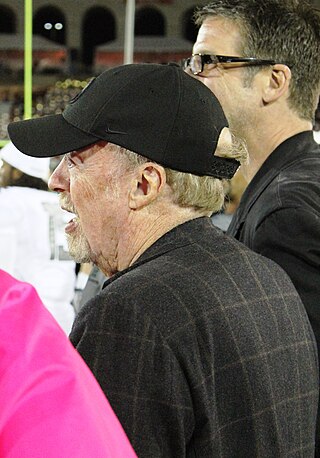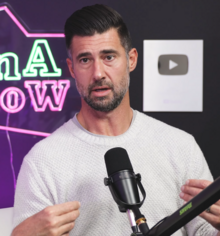
The University of Oregon is a public research university in Eugene, Oregon. Founded in 1876, the university also has two Portland locations, and manages a marine station, called the Oregon Institute of Marine Biology, in Charleston; and an observatory, called Pine Mountain Observatory, in Central Oregon.

Philip Hampson Knight is an American billionaire business magnate who is the co-founder and chairman emeritus of Nike, Inc., a global sports equipment and apparel company. He was previously its chairman and CEO. As of December 2023, Forbes estimated his net worth at $45.0 billion. He is also the owner of the stop motion film production company Laika. Knight is a graduate of the University of Oregon and the Stanford Graduate School of Business. He was part of the track and field club under coach Bill Bowerman at the University of Oregon with whom he would later co-found Nike.

Autzen Stadium is an outdoor football stadium in the northwest United States, in Eugene, Oregon. Located north of the University of Oregon campus, it is the home field of the Oregon Ducks of the Pac-12 Conference. Opened 56 years ago in 1967, the stadium has undergone several expansions. The official seating capacity is presently 54,000; however, the actual attendance regularly exceeds that figure.

The Oregon–Oregon State football rivalry is an American college football rivalry game played annually in the state of Oregon between the Ducks of the University of Oregon in Eugene and the Beavers of Oregon State University in Corvallis.

John Canzano is an American sports columnist, radio talk show host on Portland's 750 AM "The Game". The show is also syndicated in Eugene. and Klamath Falls, Oregon. From 2002 to 2022, he was the lead sports columnist at The Oregonian and a sports commentator on KGW-TV, Portland's NBC affiliate. He now writes his column at JohnCanzano.com and hosts a daily radio show called The Bald-Faced Truth.

The Oregon Ducks football program is a college football team for the University of Oregon, located in the U.S. state of Oregon. The team competes at the NCAA Division I level in the FBS and is a member of the Pac-12 Conference (Pac-12). They will join the Big Ten Conference in 2024. Although now known as the Ducks, the team was commonly called the Webfoots until the mid-1960s.

The Oregon Marching Band (OMB) is the marching band of the University of Oregon in Eugene, Oregon, United States. With over 250 members, it is the largest student organization on campus, and its members come from nearly every department and major at the university. The marching band serves as the foundation for the larger Oregon Athletic Bands organization that includes the Oregon Basketball Band, Winter Drumline, and the Green and Yellow Garter Bands.

The Platypus Trophy is a trophy awarded to the winner of the annual Oregon–Oregon State football rivalry game between the University of Oregon and Oregon State University. The trophy depicts a platypus, an animal which has features of both a duck and a beaver. For three years, from 1959 to 1961, the trophy was awarded to the winning school. The trophy was lost for more than 40 years before being rediscovered in 2005 and proposed as the game's unofficial trophy in 2007. It is currently awarded to the alumni association of the winning school.

The Oregon Duck is the mascot of the University of Oregon Ducks athletic program, based on Disney's Donald Duck character through a special license agreement. The mascot wears a green and yellow costume, and a green and yellow beanie cap with the word "Oregon" written on it.

The Matthew Knight Arena (MKA) is a 12,364-seat, multi-purpose arena in Eugene, Oregon, United States. It is home of the University of Oregon Ducks basketball teams, replacing McArthur Court. It is located on the east side of campus at the corner of Franklin Boulevard and Villard Street, a gateway to campus as people arrive from I-5. The arena was originally intended to be ready for the start of the 2010–11 basketball season, but instead opened for the men's basketball game against the USC Trojans on January 13, 2011. It is named for chief donor Phil Knight's son, Matthew Knight, who died aged 34 in a scuba diving accident. The arena cost $227 million and was designed as collaboration between TVA Architects of Portland and Ellerbe Becket of Kansas City, Missouri. Hoffman Construction Company of Portland was the general contractor.
The Oregon Ducks baseball team represents the University of Oregon in NCAA Division I college baseball in the Pac-12 Conference. The home games are played on campus at PK Park.

The 2001 Oregon Ducks football team represented the University of Oregon as a member of the Pacific-10 Conference (Pac-10) during the 2001 NCAA Division I-A football season. Led by seventh-year head coach Mike Bellotti, the Ducks compiled an overall record of 11–1 with a mark of 7–1 in conference play, winning the Pac-10 title. Oregon was invited to the Fiesta Bowl, where the Ducks beat Colorado. The team played home games at Autzen Stadium in Eugene, Oregon. The stadium was undergoing its fourth and current renovation and expansion from 41,698 in capacity to 54,000, with standing room for 60,000.

The Oregon–Washington football rivalry, also known by fans as the Border War or the Cascade Clash, is an American college football rivalry between the Oregon Ducks and Washington Huskies of the Pac-12 Conference. The respective campuses in Eugene and Seattle are 285 miles (460 km) apart, via Interstate 5. It is often regarded by fans as the fiercest and most competitive rivalry for both sides.

LaMichael Keondrae "LaMike" James is an American former professional football player who was a running back in the National Football League (NFL). He played college football for the Oregon Ducks and was selected by the San Francisco 49ers in the second round of the 2012 NFL Draft. James has also played for the Miami Dolphins.
Michael Harry Schill is an American legal scholar and academic administrator currently serving as the 17th president of Northwestern University since September 2022.
The 1970 Oregon Webfoots football team represented the University of Oregon during the 1970 NCAA University Division football season. Five home games were played in Eugene at Autzen Stadium, with one at Civic Stadium in Portland.

Thomas Tyner is a former running back in American football. He played college football with the Oregon Ducks for the 2013 and 2014 seasons, and with the Oregon State Beavers in 2017. He did not play during the 2015 and 2016 seasons due to a shoulder injury.
James Cloutier is an American illustrator, cartoonist, and graphic designer, best known for his humorous cartoon illustrations that both celebrate and poke fun at the culture of Oregon.
James Andrew Bartko was an American college athletics administrator who spent most of his professional life at the University of Oregon, as well as some years at Washington State and UC Berkeley and as athletic director at California State University, Fresno.
The Graduate Teaching Fellows Federation (GTFF) is a graduate student union at the University of Oregon (UO) established in 1976 to represent graduate student workers, and it is one of the oldest graduate student unions in the United States. Developed out of the earlier Graduate Student Employees Association, the UO administration objected to the establishment of the union, citing that graduate workers were "not public employees", but were rather "primarily students receiving a form of financial aid similar to stipends or scholarships." The Oregon Employment Relations Board (ERB) ruled in favor of the graduate students and supported their right to organize. The GTFF began organizing its first contract in April 1977 with the University of Oregon administration. The negotiations reached an impasse in 1978, and it was not until after two strike votes that an agreement was reached. In 1989, the GTFF secured subsidies for health insurance, which was expanded in 1993 to be fully employer-paid, one of the first such programs offered to graduate teachers in the United States.













